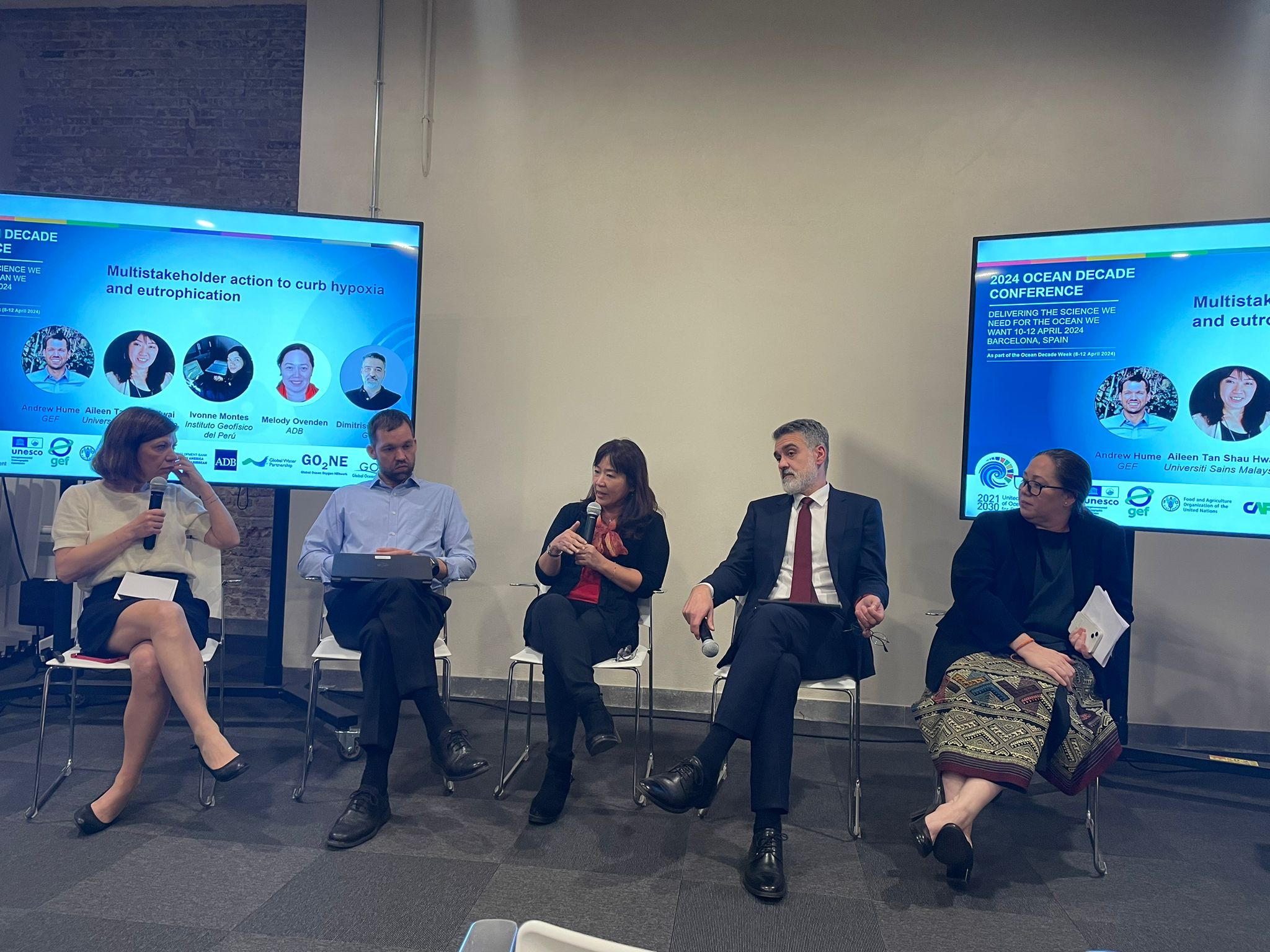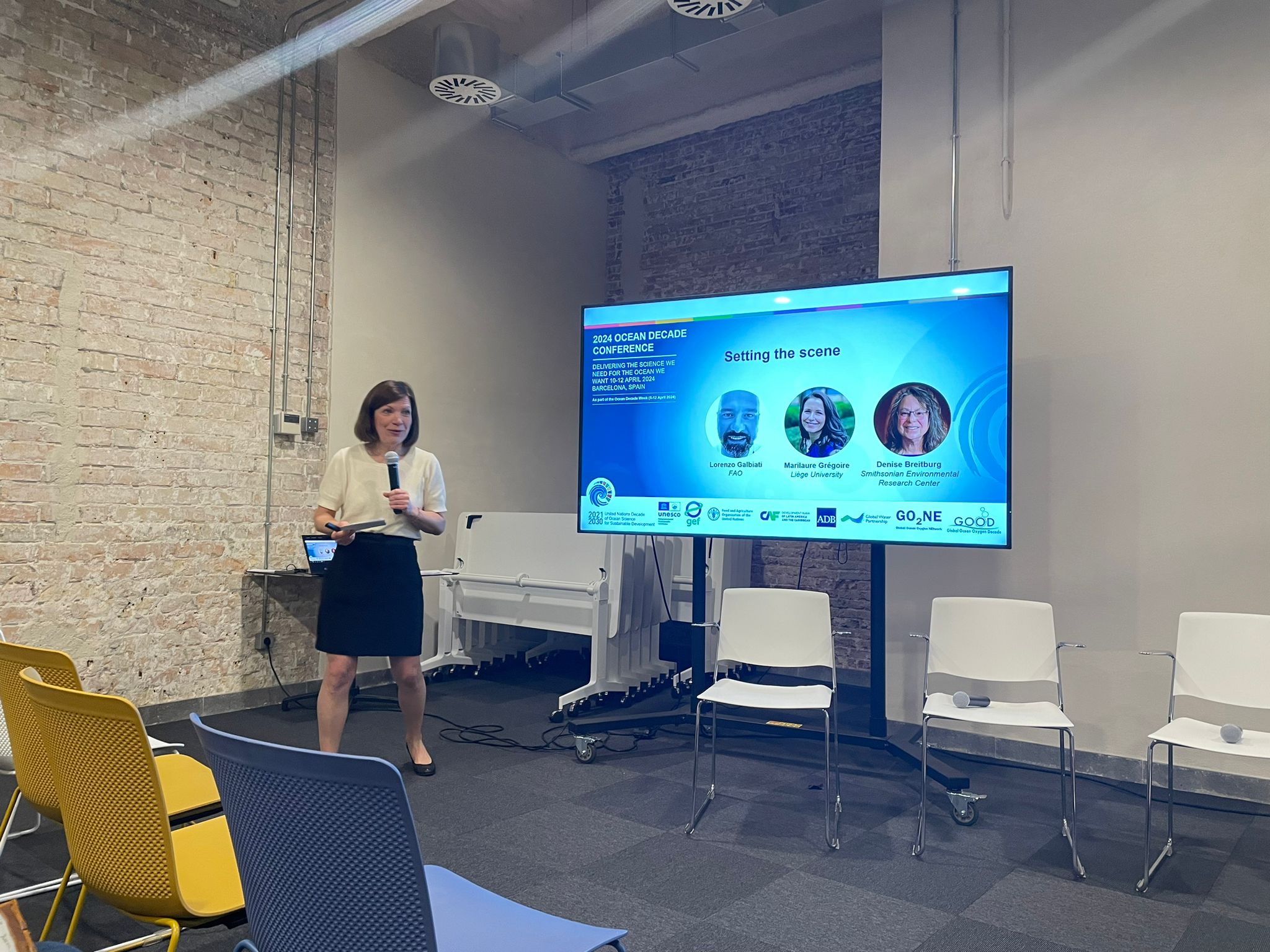 News
News
New approaches to combat eutrophication and hypoxia
 "The satellite event 'New approaches to combat eutrophication and hypoxia' brought together partners under the GEF-8 Clean and Healthy Ocean Integrated Program (CHO-IP) for introductions and to begin the next phase of tackling eutrophication and hypoxia in 14 national child projects.
"The satellite event 'New approaches to combat eutrophication and hypoxia' brought together partners under the GEF-8 Clean and Healthy Ocean Integrated Program (CHO-IP) for introductions and to begin the next phase of tackling eutrophication and hypoxia in 14 national child projects.
Representatives of partner organisations, the Food and Agriculture Organization of the United Nations (FAO), Asian Development Bank (ADB), Development Bank for Latin America (CAF), European Bank for Reconstruction and Development (EBRD), together with the IOC-UNESCO Global Ocean Oxygen Network (GO2NE) and the Global Water Partnership (GWP) discussed the program aims and objectives over the course of a 90 minute deoxygenation primer, panel discussion and Q&A session.
Keys points expressed by participants included that:
- Partners across scales and sectors must be involved early, with appropriate financing mechanisms, and engaged throughout to foster project ownership and outcome longevity.
- Scientific data, and methods of access, must be shared openly.
- Science will be unheeded unless it is delivered in a manner that is clear, timely, intelligible, and contextualised and translated to those who have, or will have, the capacity to use it.
- Collaboration with regional actors must be enhanced to aid identification of the most effective science-based actions that will have the highest impact in regional contexts, rather than following global trends.
- International institutions must be encouraged to identify and engage with initiatives of actors in their networks that may already be addressing or adapting to hypoxic conditions.
- Scientifically well-versed personnel are needed in Development Banks and other institutions positioned to leverage existing networks to tackle deoxygenation and other marine issues.
Partners will now move ahead with the program's Global Coordination Project and begin to make connections to national actors and networks working to address eutrophication and hypoxia and implement the program in the 14 participating countries.
The program will synergise with the Global Ocean Oxygen Database and Atlas (GO2DAT), an endorsed action under the UN Ocean Decade of Ocean Science for Sustainable Development and may lead to the development of new Actions as the program is implemented."
Contact: go2ne-secretariat@unesco.org
More information:
The 'New approaches to combat eutrophication and hypoxia' event
The GEF Clean and Healthy Ocean Program
IOC-UNESCO program announcement


Persistent eutrophication and hypoxia in the coastal ocean
Abstract. 
"Coastal eutrophication and hypoxia remain a persistent environmental crisis despite the great efforts to reduce nutrient loading and mitigate associated environmental damages. Symptoms of this crisis have appeared to spread rapidly, reaching developing countries in Asia with emergences in Southern America and Africa. The pace of changes and the underlying drivers remain not so clear. To address the gap, we review the up-to-date status and mechanisms of eutrophication and hypoxia in global coastal oceans, upon which we examine the trajectories of changes over the 40 years or longer in six model coastal systems [...]".
Source: Cambridge University Press
Authors: Minhan Dai et al.
DOI: https://doi.org/10.1017/cft.2023.7
Editorial: Regional coastal deoxygenation and related ecological and biogeochemical modifications in a warming climate
Abstract. 
"Coastal ecosystems play tremendous roles in socio-economic development, but their functions are degrading due to human activities. One of the most alarming degradations is coastal deoxygenation, driven primarily by the over-enrichment of anthropogenic nutrients and organic matter (eutrophication) in the coastal waters. The coastal deoxygenation has led to the worldwide spread of hypoxic zones (where dissolved oxygen concentration is less than 2 mg/L), with the number of reported hypoxic sites increasing from 45 in the 1960s to around 700 nowadays. Besides being perturbed by human activities locally, coastal waters respond more rapidly than [...]".
Source: Frontiers
Authors: Wenxia Zhang et al.
DOI: https://doi.org/10.3389/fmars.2023.1146877
Short exposure to oxygen and sulfide alter nitrification, denitrification, and DNRA activity in seasonally hypoxic estuarine sediments
Abstract.
 "Increased organic loading to sediments from eutrophication often results in hypoxia, reduced nitrification and increased production of hydrogen sulfide, altering the balance between nitrogen removal and retention. We examined the effect of short-term exposure to various oxygen and sulfide concentrations on sediment nitrification, denitrification and DNRA from a chronically hypoxic basin in Roskilde Fjord, Denmark. Surprisingly, nitrification rates were highest in the hypoxic and anoxic treatments (about 5 μmol cm−3 d−1) and the high sulfide treatment was not significantly different than the oxic treatment. [...]"
"Increased organic loading to sediments from eutrophication often results in hypoxia, reduced nitrification and increased production of hydrogen sulfide, altering the balance between nitrogen removal and retention. We examined the effect of short-term exposure to various oxygen and sulfide concentrations on sediment nitrification, denitrification and DNRA from a chronically hypoxic basin in Roskilde Fjord, Denmark. Surprisingly, nitrification rates were highest in the hypoxic and anoxic treatments (about 5 μmol cm−3 d−1) and the high sulfide treatment was not significantly different than the oxic treatment. [...]"
Source: FEMS Microbiology Letters
Authors: Jane M. Caffrey, Stefano Bonaglia, Daniel J. Conley
DOI: 10.1093/femsle/fny288
Nitrogen – ocean plastics pollution’s forgotten neighbour
" Tremendous – and deserved - attention has been paid for the last few years to the scourge of ocean plastics pollution, which we now know reaches the farthest depths of the ocean and can have impacts on ocean life from the smallest plankton to the largest whales. We know (Jambeck et al., 2015) that some 4.8 million to 12.7 million metric tonnes of plastic enter the ocean each year. UN Environment has estimated the socio-economic costs of ocean plastics pollution at about US$13 billion per year. We are only beginning to explore and understand the potential human health impacts of plastics in the oceanic food chain. [...]"
Tremendous – and deserved - attention has been paid for the last few years to the scourge of ocean plastics pollution, which we now know reaches the farthest depths of the ocean and can have impacts on ocean life from the smallest plankton to the largest whales. We know (Jambeck et al., 2015) that some 4.8 million to 12.7 million metric tonnes of plastic enter the ocean each year. UN Environment has estimated the socio-economic costs of ocean plastics pollution at about US$13 billion per year. We are only beginning to explore and understand the potential human health impacts of plastics in the oceanic food chain. [...]"
Source: United Nations Development Programme
Author: Andrew Hudson
High total organic carbon in surface waters of the northern Arabian Gulf: Implications for the oxygen minimum zone of the Arabian Sea
Abstract.
" Measurements of total organic carbon (TOC) for two years in Kuwaiti waters showed high TOC levels (101.0–318.4, mean 161.2 μM) with maximal concentrations occurring within the polluted Kuwait Bay and decreasing offshore, indicating substantial anthropogenic component. Analysis of winter-time data revealed a large increase in density over the past four decades due to decrease in Shatt Al-Arab runoff, implying that the dissolved/suspended organic matter in surface waters of the northern Gulf could be quickly injected into the Gulf Deep Water (GDW). [...]"
Measurements of total organic carbon (TOC) for two years in Kuwaiti waters showed high TOC levels (101.0–318.4, mean 161.2 μM) with maximal concentrations occurring within the polluted Kuwait Bay and decreasing offshore, indicating substantial anthropogenic component. Analysis of winter-time data revealed a large increase in density over the past four decades due to decrease in Shatt Al-Arab runoff, implying that the dissolved/suspended organic matter in surface waters of the northern Gulf could be quickly injected into the Gulf Deep Water (GDW). [...]"
Source: Marine Pollution Bulletin
Authors: Turki Al-Said et al.
DOI: 10.1016/j.marpolbul.2018.02.013
Exposure to elevated pCO2 does not exacerbate reproductive suppression of Aurelia aurita jellyfish polyps in low oxygen environments
Abstract.
" Eutrophication-induced hypoxia is one of the primary anthropogenic threats to coastal ecosystems. Under hypoxic conditions, a deficit of O2 and a surplus of CO2 will concurrently decrease pH, yet studies of hypoxia have seldom considered the potential interactions with elevated pCO2 (reduced pH). Previous studies on gelatinous organisms concluded that they are fairly robust to low oxygen and reduced pH conditions individually, yet the combination of stressors has only been examined for ephyrae. [...]"
Eutrophication-induced hypoxia is one of the primary anthropogenic threats to coastal ecosystems. Under hypoxic conditions, a deficit of O2 and a surplus of CO2 will concurrently decrease pH, yet studies of hypoxia have seldom considered the potential interactions with elevated pCO2 (reduced pH). Previous studies on gelatinous organisms concluded that they are fairly robust to low oxygen and reduced pH conditions individually, yet the combination of stressors has only been examined for ephyrae. [...]"
Source: Marine Ecology Progress Series
Authors: Laura M. Treible et al.
DOI: 10.3354/meps12298
Read the full article here.
Oxic-anoxic regime shifts mediated by feedbacks between biogeochemical processes and microbial community dynamics
Abstract.
" Although regime shifts are known from various ecosystems, the involvement of microbial communities is poorly understood. Here we show that gradual environmental changes induced by, for example, eutrophication or global warming can induce major oxic-anoxic regime shifts. We first investigate a mathematical model describing interactions between microbial communities and biogeochemical oxidation-reduction reactions. [...]"
Although regime shifts are known from various ecosystems, the involvement of microbial communities is poorly understood. Here we show that gradual environmental changes induced by, for example, eutrophication or global warming can induce major oxic-anoxic regime shifts. We first investigate a mathematical model describing interactions between microbial communities and biogeochemical oxidation-reduction reactions. [...]"
Source: Nature Communications
Authors: Timothy Bush et al.
DOI: 10.1038/s41467-017-00912-x
Macroalgal Blooms on the Rise along the Coast of China
Abstract.
" A broad spectrum of events that come under the category of macroalgal blooms are recognized world-wide as a response to elevated levels of eutrophication in coastal areas. In the Yellow Sea of China, green tides have consecutively occurred 10 years, which is considered as the world’s largest Ulva blooms. However, in recently years, golden tides caused by Sargassum seaweed have also been on the rapid rise, resulting in dramatic damage to the environment and economy again. [...]"
A broad spectrum of events that come under the category of macroalgal blooms are recognized world-wide as a response to elevated levels of eutrophication in coastal areas. In the Yellow Sea of China, green tides have consecutively occurred 10 years, which is considered as the world’s largest Ulva blooms. However, in recently years, golden tides caused by Sargassum seaweed have also been on the rapid rise, resulting in dramatic damage to the environment and economy again. [...]"
Source: Oceanography & Fisheries
Authors: Jianheng Zhang, Yuanzi Huo and Peimin He
DOI: 10.19080/OFOAJ.2017.04.555646
Historical records of coastal eutrophication-induced hypoxia
Abstract.
 "Under certain conditions, sediment cores from coastal settings subject to hypoxia can yield records of environmental changes over time scales ranging from decades to millennia, sometimes with a resolution of as little as a few years. A variety of biological and geochemical indicators (proxies) derived from such cores have been used to reconstruct the development of eutrophication and hypoxic conditions over time. [...]"
"Under certain conditions, sediment cores from coastal settings subject to hypoxia can yield records of environmental changes over time scales ranging from decades to millennia, sometimes with a resolution of as little as a few years. A variety of biological and geochemical indicators (proxies) derived from such cores have been used to reconstruct the development of eutrophication and hypoxic conditions over time. [...]"
Source: Biogeosciences
Authors: A. J. Gooday et al.
DOI: 10.5194/bg-6-1707-2009
 Newsletter
Newsletter
It is possible to subscribe to our email newsletter list.
Depending on the amount of publications, we will summarize the activities on this blog in a newsletter for everyone not following the blog regularly.
If you want to subscribe to the email list to receive the newsletter, please send an email to sfb754@geomar.de with the header "subscribe".
If you want to unsubscribe from the newsletter, please send an email to sfb754@geomar.de with the header "unsubscribe".
You cannot forward any messages as a regular member to the list. If you want to suggest new articles or would like to contact us because of any other issue, please send an email to sfb754@geomar.de.

 To follow GOOD on LinkedIn, please visit
To follow GOOD on LinkedIn, please visit  To follow GOOD on Twitter, please visit
To follow GOOD on Twitter, please visit  To follow GOOD on Blue Sky, please visit
To follow GOOD on Blue Sky, please visit